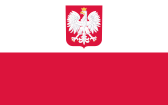
Back የፖላንድ ሰንደቅ ዓላማ Amharic علم بولندا Arabic علم بولندا ARZ Polşa bayrağı Azerbaijani Kobér Polandia BAN Lėnkėjės vieleva BAT-SMG Сцяг Польшчы Byelorussian Сьцяг Польшчы BE-X-OLD Национално знаме на Полша Bulgarian পোল্যান্ডর ফিরালহান BPY
You can help expand this article with text translated from the corresponding article in Polish. (May 2022) Click [show] for important translation instructions.
|
 | |
| Flag of the Republic of Poland | |
| Use | National flag |
|---|---|
| Proportion | 5:8 |
| Adopted | 1 August 1919 (officially) 31 January 1980 (restored) |
| Design | A horizontal bicolour of white and red |
| Flag with coat of arms of the Republic of Poland | |
 | |
| Use | State flag, civil and state ensign |
| Proportion | 5:8 |
| Adopted | 1919; last modified 1990 |
| Design | A horizontal bicolour of white and red defaced with the arms of Poland in the white stripe. |
 | |
| Use | Naval ensign |
| Proportion | 10:21 |
| Adopted | 19 February 1993 |
| Design | A flag consisting of two stripes, white and red, terminated in two triangular tongues on a free leech. In the center of the white strip, in the part between the louvre and the apex of the indentation between the tongues, is the emblem of the Republic of Poland. |
| Pennant of the president of the Republic of Poland | |
 | |
| Use | Presidential standard |
| Proportion | 5:6 |
| Adopted | 1919 (original) 1927 (officially) 26 January 1996 (restored) |
| Design | Crowned white eagle in a red field bordered with a white wavy line. |
The national flag of Poland (flaga Polski [ˈfla.ɡa ˈpɔl.ski]) consists of two horizontal stripes of equal width, the upper one white and the lower one red. The two colours are defined in the Polish constitution as the national colours. A variant of the flag with the national coat of arms in the middle of the white fess is legally reserved for official use abroad and at sea. A similar flag with the addition of a white eagle is used as the naval ensign of Poland.
White and red were officially adopted as national colours in 1831, although these were associated with Poland since the Middle Ages and were emphasized on royal banners. They are of heraldic origin and derive from the tinctures (colours) of the coats of arms of the two constituent nations of the Polish–Lithuanian Commonwealth (i.e., the White Eagle of Poland, and the Pursuer of the Grand Duchy of Lithuania, a white knight riding a white horse), both on a red shield.
Until 1831, Polish soldiers wore cockades of various colour combinations. The national flag was officially adopted in 1919. Since 2004, Polish Flag Day has been celebrated on 2 May.
The flag is flown continuously on the buildings of the highest national authorities, such as the parliament and the presidential palace. Other institutions and many Polish people fly the national flag on national holidays and other special occasions of national significance. Current Polish law does not restrict the use of the national flag without the coat of arms, as long as the flag is not disrespected.
Horizontal bicolours of white and red being a relatively widespread design, several flags are similar but unrelated to the Polish one. Two national flags (Indonesia and Monaco) have the red stripe above the white one. In Poland, many flags based on the national design also feature the national colours.
It is one of five flags that use the 5:8 ratio. The other four flags include those of Argentina, Guatemala, Palau, and Sweden.